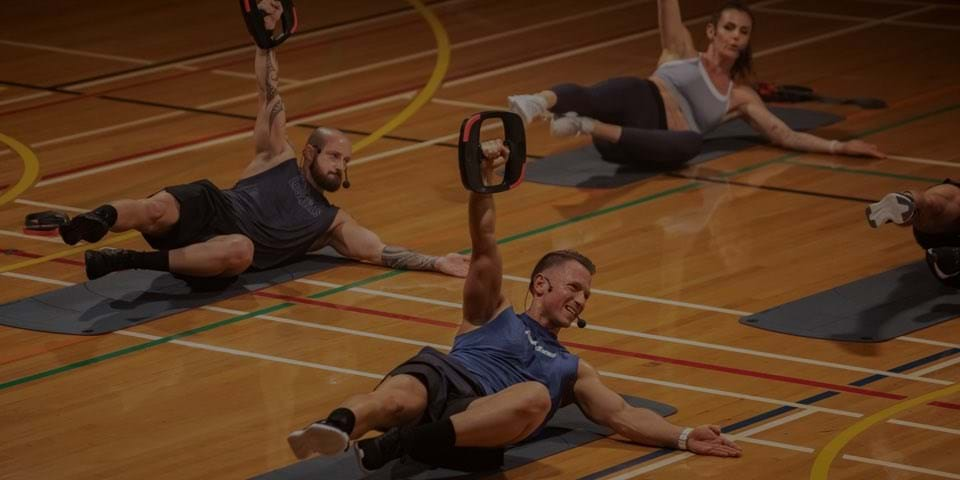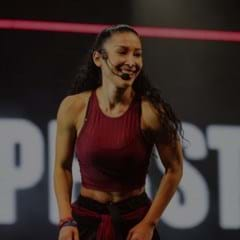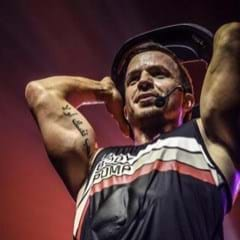GLEN OSTERGAARD: The programs live and die on the quality of the music. For BODYPUMP™ and RPM™, I tend to stick to well-known mainstream artists, where you can rely on quality vocals and full studio production of mixes. For LES MILLS SPRINT™ I live on the wild side!
In general the music must have the right feel for each program, because the feel dictates the movement. I listen to a lot of songs every round, I’m not sure how many but I can tell with a quick listen or blink listen if it’s suitable or not.
LISA OSBORNE: Music is everything! Music drives the movement. Music is the key to capturing the essence of the program. Music inspires creativity and is the magic in the creation!
I listen to thousands of songs – when walking, shopping, cooking, resting, and all throughout the day....
I love to walk or run and just listen to songs. I listen when I do the housework and even in the shower!
Sometimes I love a song but it doesn’t have enough contrast so I let it go – but the ones I find that I’m singing along to – that make me smile and feel good inside – these are the great ones!
RACHAEL NEWSHAM: Music is the oxygen in our dancing veins when it comes to SH’BAM™… it has to evoke an emotional response for me. Full stop. If it doesn’t, then I am not connecting to and dancing from my heart, and that flies in the face of the essence of the program: connection. Bringing people out of themselves and releasing their inhibitions.
These days, inhibitions are increasing tenfold as people compare their lives to the lives of the social media “influencers” they follow. I look forward to a return of the community where people connect to their circle, rather than comparing themselves with it. SH’BAM is a powerful community of acceptance and love. For me, it is more and more important to let people express themselves in a safe, non-judgmental environment. This is why I created SH’BAM. Dance is one of life’s short-cuts to happiness and it’s time more people know about it. Music is the key to that door…
DAN COHEN: Music is single-handedly the most important influencer in my creative role. It is the magic of a song that dictates the pace, feel, length, drama, and intensity of our choreography. As each round is created, the pool of music is varied, often listening to playlists pulled in from DJs, iTunes, Spotify… along with the music team, I could be listening hundreds of songs. The most challenging part of choosing music is refining the list into a journey that creates the ultimate magic.
GANDALF ARCHER MILLS: For a BODYJAM™ release that has like 20 songs on it, I will apply to license 60 or 70 and half of them will get denied straight away. When you’re trying to license music for 70 plus countries, it’s very complicated! Of the remaining songs, a bunch of them just won’t clear – they just sit there and we’re emailing the labels and trying to negotiate with them and they just won’t go anywhere… then a bunch of songs turn green and I’ll sculpt the program out of the best of those songs. I’ll make sure I’ve got lots of different genres, styles, and sounds of music that I like. And that’s what it comes down to a lot of time – it’s all music that I really like. I don’t put songs in BODYJAM that I don’t like.
MARK NU’U-STEELE: The search for awesome music never stops. While I’m working on one release, I’m already searching for new music for future releases.
Bodysteppers love to sing along as they work out, some in their head, and some out loud. I therefore choose music that is instantly catchy, melodic, and for the peak tracks – sounds with a high energy, strong and driving beat. There’s a lot of contrast as we move from track to track in BODYSTEP™, so I like to explore different musical styles in between the peak tracks to create that contrast.
ERIN MAW: We’re always looking for innovative songs that keep LES MILLS GRIT™ on trend with fresh feels. A lot of it has to be independent music because we edit it a lot and add in countdowns. My top three favorite artists we’ve ever used in LES MILLS GRIT are 20syl, Kanye West and Hudson Mohawk.
CHRIS RICHARDSON: Music plays a massive role in THE TRIP™. The Music is effectively our score or soundtrack for the visuals, or the movie. The music is instrumental – no pun intended – in enhancing such things as the intensity of the workout, the aesthetic or mood of what we are viewing, and the style of delivery the Instructor chooses to use, especially their vocal delivery.
Instructors are trained to apply the 80/20 approach which basically means 80 percent of the time it’s about the music and visuals and 20 percent of the time it’s about what they do to enhance the experience.
DIANA ARCHER MILLS ON THE EVOLUTION OF THE MUSIC:
Over the last few years we realised that in order to keep our products really relevant and ahead of the trend, we needed to get more input from industry leaders and insiders. We work with Dan Aux who is one of the leading DJs in New Zealand. Music is his life and he’s across upcoming trends in the music industry, so we ask him for song suggestions every round. These get distributed not only to the Program Directors but also to Ezra Fantl, who is part of our Product Innovation Team. He is devoted to updating and refreshing the sound of our programs. He will filter Dan Aux’s tracks and pass these on to the Program Directors, so we end up with a selection of music that comes from Dan Aux, Ezra, and whatever we are listening to ourselves as Program Directors.
Program Directors then sit down with our Creative Directors and take them through what we think is going to work with the journey of the class. Sometimes we’re not sure where we want to go, if we want to take the program in a new direction, we have a cool idea but we’re not sure if the sound will work… sometimes it can be really loose and we’ll use those meetings with our Creative Director to really cement what the release is going to be musically. And sometimes it can be, this is basically the class, I’ve got all the choreography in my mind and this is how it’s going to sound and if that’s the case most of the time the Creative Director is like, yes, yes, yes!
BODYCOMBAT AND RPM SOUNDS
We’ve spent the last few years modernising BODYCOMBAT™ and really shifting it and we aim to use at least 50 percent of tracks from Ezra’s list. We try to make it younger than traditional consumers would like it to be. Whereas in RPM, the sound works well the way it is: there are specific genres that work in RPM, it’s just really a logical flow of where the class is going to go – you know there’s not much evolution to the music over releases. Although in saying that, Glen says it takes him longer to choose the music for RPM than for BODYPUMP because RPM is so reliant on the music, even more so than our less dynamic programs. Because you’re stuck on a bike, it’s all about the musical journey and it’s so subtle – when the movements are really limited you can’t go, this is a crazy sound, I’ll do some wild choreography to match it.
We try to have backups in place for all our songs because of the licensing process. That way, we can start choreographing to our ideal list, then if the track gets denied for whatever reason we have the choice of covering it or replacing it with another track. If the release doesn’t feel like it’s really reliant on that particular sound or that particular concept, we’ll replace it. But if it’s a sound that we feel we can cover and it’s going to work really well and it’s a sound that we really want to use then we apply for a cover.
DIFFERENCE BETWEEN CREATIVE DIRECTOR AND PROGRAM DIRECTOR
If a release were a newspaper article, the Creative Directors are the editors. The Program Director is responsible for the creation of the product, and we are responsible for assisting them with music and choreography selection. We edit it to make sure it’s balanced and feels right and feels good and we’re across current trends and the direction of where the program is heading. The Program Director is the wild creative who’s responsible for the creation and we’re either reigning them back in, or pushing them forward.
As Program Director, you can get really caught up in a particular idea or sound. For example, with BODYJAM, the biggest issue Gandalf has is that he will let a block get really flat because the music is really cool and he’s really enjoying it and it makes sense superficially… if you’re living within that you can get into the depth of it. However, to do it as an outsider who is not a professional dancer it doesn’t feel good to be in that same sound for too long. So that’s one of our main goals within the music selection process as Creative Directors – to maintain the musical journey and drive new sounds forward in the program.
Check out our interview with the Music Team for more on what goes on behind the scenes.







